choosing a name
| No matter what kind of site or business you're naming, your basic goal is always the same: You want a name that sticks in users' minds and helps you stand out from the pack. But there are three distinct philosophies on how to accomplish that goal online. 3 kinds of site names:
the dot-com name One popular approach to naming web sites is to choose the most generic name possible, and add a "dot-com" on the end as in computers.com or news.com or an "e" on the beginning, as in eToys or eGreetings. This naming trend hit its peak in the late '90s, when nearly every word in the Oxford English Dictionary was registered as a dot-com domain name. Long-standing companies repositioned themselves as internet start-ups by renaming themselves or spinning off new businesses with "e" and "i" in the name. The motivation was largely financial: an effort to reassure stockholders about a company's internet strategy and convince investors that it deserved a dot-com valuation. It should come as no surprise, then, that companies began shedding their dot-coms as soon as the financial climate turned. In 2000, many recently minted dot-coms changed their names back. the unusual name An alternate naming philosophy leans toward unusual, and not necessarily descriptive, names. This is sometimes referred to as the "empty vessel" approach to branding: You choose a word with little or no intrinsic meaning an "empty semantic vessel," if you will so you can define your brand and the word at the same time. This approach is well-suited to established businesses as they come online, such as Gap.com, Walmart.com, and Marthastewart.com. But for new businesses it's risky, because it doesn't make your life any easier: It won't help your search engine listings, and it won't help users understand what you do. Despite the risks, this approach has worked wonders for some of the web's most successful sites, including Amazon.com (the leading retail store), Google (the leading search engine), and Yahoo! (a leading portal). Whether they succeeded because of their names or despite them is anyone's guess. the combination name It's hard to decide between these two approaches, because if you're like me you want it all. On one hand, you want a name that's distinctive so it will stick in users minds. On the other hand, you want a name that's clear, so users will immediately have a sense of what you do. There is a middle path. It's possible to choose a name that reaps the benefits of both approaches. A combination name is
This is no small task, but it can be done. A few successful examples include Babycenter, Ask Dr. Weil, BlackPlanet, and Animation Express. |
EAN: 2147483647
Pages: 195
